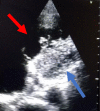Prognostic value of point-of-care ultrasound during cardiac arrest: a systematic review
- PMID: 31931808
- PMCID: PMC6958750
- DOI: 10.1186/s12947-020-0185-8
Prognostic value of point-of-care ultrasound during cardiac arrest: a systematic review
Abstract
Background: Despite significant improvements in cardiopulmonary resuscitation, sudden cardiac arrest is one of the leading causes of mortality in the United States. Ultrasound is a widely available tool that can be used to evaluate the presence of cardiac wall motion during cardiac arrest. Several clinical studies have evaluated the use of ultrasound to visualize cardiac motion as a predictor of mortality in cardiac arrest patients. However, there are limited data summarizing the prognostic value of point of care ultrasound evaluation during resuscitation. We performed a systematic literature review of the existing evidence examining the clinical utility of point-of-care ultrasound evaluation of cardiac wall motion as a predictor of cardiac resuscitation outcomes.
Methods/results: We performed a systematic PubMed search of clinical studies up to July 23, 2019 evaluating point-of-care sonographic cardiac motion as a predictor of mortality following cardiac resuscitation. We included studies written in English that reviewed short-term outcomes and included adult populations. Fifteen clinical studies met inclusion criteria for assessing cardiac wall motion with point-of-care ultrasound and outcomes following cardiac resuscitation. Fourteen of the fifteen studies showed a statistically significant correlation between the presence of cardiac motion on ultrasound and short-term survival. This was most evident in patients with ventricular fibrillation or ventricular tachycardia as a presenting rhythm. Absence of cardiac motion non-survival. The data were pooled and the overall pooled odds ratio for return of spontaneous circulation in the presence of cardiac motion during CPR was 12.4 +/1 2.7 (p < 0.001).
Conclusion: Evaluation of cardiac motion on transthoracic echocardiogram is a valuable tool in the prediction of short-term cardiac resuscitation outcomes. Given the safety and availability of ultrasound in the emergency department, it is reasonable to apply point-of-care ultrasound to cardiopulmonary resuscitation as long as its use does not interrupt resuscitation.
Keywords: Cardiac arrest; Circulation; Echocardiogram; POCUS; Point-of-care ultrasound; Return of spontaneous; Ultrasound.
Conflict of interest statement
The authors declare that they have no competing interests.
Figures




References
-
- Gaspari R, Weekes A, Adhikari S, Noble VE, Nomura JT, Theodoro D, et al. Emergency department point-of-care ultrasound in out-of-hospital and in-ED cardiac arrest. Resusc. 2016;109:33–39. - PubMed
Publication types
MeSH terms
LinkOut - more resources
Full Text Sources
Medical
Miscellaneous

